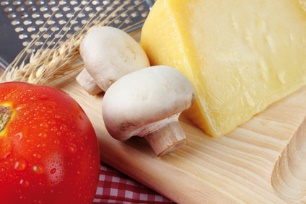
There have been a lot of strong opinions about MSG, also known as monosodium glutamate, over the years. But is it really something to avoid? After all, you are probably eating it more often than you thought!
Let’s break down the mystery of MSG, figure out if it deserves the side-eye, and take a look at which everyday foods might be packing a punch of umami because of it.
What is MSG?
MSG is a seasoning that gives food a rich, savory taste. Think of the depth you get from a slow-cooked stew or a perfectly ripe tomato, and you will know the flavor.
It was first discovered in Japan in the early 1900s when a scientist, Kikunae Ikeda, determined that the amino acid glutamate was the compound that gave seaweed broth its deliciously satisfying taste. He began isolating the glutamate and selling it as a seasoning.
Glutamate, as MSG, is still available as a seasoning to this day, and continues to be naturally found in many foods beyond seaweed, like mushrooms, aged cheeses, and walnuts, to name a few.
Should You Avoid MSG?
The idea that MSG should be avoided started in 1968 when the New England Journal of Medicine published a letter (not a research study or anything based on science) that described adverse symptoms a physician experienced after eating at Chinese restaurants. The writer guessed that MSG, cooking wine, or excessive salt might be to blame for what he experienced. The public singled out MSG as the culprit, and dubbed the phenomenon “Chinese Restaurant Syndrome” without any actual investigation into his symptoms.
This negative perception of MSG was not just about health concerns. It also had racial undertones. The food from Chinese restaurants in particular was unfairly targeted despite the fact that MSG was widely used in many types of cuisine and processed foods.
 Since then, many studies have looked into whether MSG could have any negative effects. What they have found is that:
Since then, many studies have looked into whether MSG could have any negative effects. What they have found is that:
- The FDA and health authorities of other countries around the world have evaluated all of the studies on MSG and deemed it to be safe.
- Negative MSG reactions are rare and in response to extremely large doses of it being eaten on an empty stomach. The reactions are often not reproducible under controlled conditions.
Our bodies naturally produce glutamate, and cannot distinguish between the glutamate we eat and that which we make. That makes it highly unlikely that the glutamate from MSG would cause adverse health effects when eaten.
Everyday Foods Containing MSG
Even if you think you’re avoiding MSG, you are probably not. Here are some foods that commonly contain MSG.
- Frozen meals – Frozen meals may contain MSG for flavoring purposes and/or to reduce the need for salt in seasoning them.
- Restaurant food – Both fast food and sit-down restaurants may season their food with MSG. MSG is used across cuisines, not just in Chinese food.
- Snack foods – Foods like chips or flavored crackers may contain MSG as part of the seasoning blend.
- Canned soups and broths – Canned soups, bouillon cubes, and canned or boxed broths may contain MSG to help give them a deep meaty taste. MSG may also be used in these to lower the sodium content without negatively affecting the flavor.
- Seasoning blends – Spice mixes, marinades, and rubs may contain MSG to give them more flavor or balance the flavors of the other ingredients.
- Processed meats – Sausage, hot dogs, and deli meats may contain MSG for flavor.
Everyday Foods Containing Glutamate
 Many foods naturally contain glutamate. Some of the foods highest in glutamate that you may be eating frequently are ham, parmesan cheese, and dried tomatoes. For a more complete list, check out Monosodium Glutamate 101: What Foods Naturally Contain MSG?.
Many foods naturally contain glutamate. Some of the foods highest in glutamate that you may be eating frequently are ham, parmesan cheese, and dried tomatoes. For a more complete list, check out Monosodium Glutamate 101: What Foods Naturally Contain MSG?.
Recognizing MSG in Foods
MSG must be labeled on the ingredient list of food packages when it is present. Other ingredients like hydrolyzed vegetable protein, autolyzed yeast extract, and yeast extract can also add glutamate to foods, and must be labeled as well.
Foods with packaging claims of “contains no MSG”, “no MSG added” and “no added MSG” will not have added MSG in them, but still may contain naturally occurring sources of glutamate like tomatoes or cheese.
The Takeaway
MSG is a naturally derived seasoning found in a variety of everyday foods, not just Chinese takeout. It may add flavor to a food, enhance or balance other flavors in the food, or be used to preserve flavor in lower-sodium foods. Foods labeled “no added MSG” do not contain added MSG, but may still contain glutamate from other ingredients. Scientific reviews by many different health agencies have deemed MSG safe to eat.
Related Reading:

